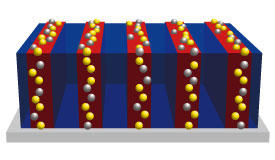

07/30/2018

Adapted with permission from Ref. 1. Copyright 2018 American Chemical Society
Inspired by a protein that helps mussels strongly cling to surfaces, AIMR researchers have devised a way to make a polymer film embedded with two kinds of nanoparticles: one plasmonic and the other magnetic1. This hybrid film is promising for imaging magnetic fields and for use in magneto-optical devices.
Mussels can adhere to a wide variety of materials due to the strong adhesion of mussel foot proteins. The main functional group of mussel foot proteins is catechol, which has strong adhesion and chemical reduction properties.
Now, Hiroshi Yabu of the AIMR at Tohoku University and colleagues have introduced this catechol group into a diblock polymer — a polymer made up of two alternating two building blocks (i.e., ABABAB…, where A and B are two chemical groups; for example, poly(vinyl catechol) and polystyrene in this study). “Only a few diblock copolymers containing the catechol group were reported prior to our study as catechol inhibits radical polymerization,” notes Yabu.
The team next employed a two-step process that cleverly exploits the multifunctional properties of the catechol group to first add iron oxide nanoparticles and then silver nanoparticles to the diblock polymer (see image). The ability of catechol to include metal atoms in its structure enables it to incorporate the iron oxide nanoparticles, whereas catechol’s reduction properties bring in the silver nanoparticles.
The combination of silver and iron oxide nanoparticles gives the hybrid polymer interesting properties. The iron oxide nanoparticles exhibit a phenomenon known as the magneto-optical Kerr effect (MOKE), while the silver nanoparticles enhance this effect by boosting the electromagnetic field in their vicinity. In the MOKE, the magnetic properties of a material alter the properties of light reflected from the material’s surface, making it a powerful way to probe the local magnetization of materials.
“The MOKE is used in magnetic memory devices and future spintronics devices,” says Yabu. “Our binary nanoparticle assembly enhanced MOKE signals by co-assembly of plasmonic nanoparticles and magnetic nanoparticles, which opens the way to high density and highly sensitive magnetic devices.”
The film could have much wider application by incorporating different pairs of nanoparticles. “This result indicates that our mussel-inspired diblock copolymer thin film is a promising platform for developing well-ordered hybrid thin films containing different nanoparticles,” comments Yabu.
Yabu notes that the interdisciplinary environment at the AIMR was vital for developing the film. “This work is an example of the significant results from ‘fusion research’ between three laboratories at the AIMR working on polymer science, inorganic nanoparticles and spintronics,” he says.
This research highlight has been approved by the authors of the original article and all information and data contained within has been provided by said authors.